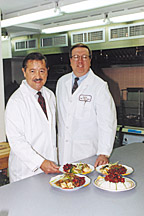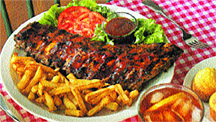

Kenniston:Barbecue-type products such as ribs are traditionally cooked in a batch process, typically in a smokehouse or via the boil-in-bag method which retains product juices. Our process, by contrast, is continuous flow. We start by searing the product with high, quick heat at 1,300 degrees F to vaporize the exterior fat yet retain the juices and natural flavors, and to give it "just off the grill" texture. The continuous process is relatively new for these kinds of products, and it applies to other bone-in products such as pork chops, short ribs and poultry as well.
FE: What would a continuous production line consist of?
Kenniston: The process combines conduction heat with convection heat. Depending on the product, a typical line might consist of vacuum-tumbling or injection equipment, a gas-fired searing oven for conduction heating, a spiral or multi-pass steam oven for convection heating, a spiral freezer, and packaging equipment for bulk, bagged or vacuum-packed product - depending on what the customer wants - and quality-assurance tests. It's all conventional equipment, but we modify it to do a few things exceptionally well.
FE: As compared to the conventional processes, what are the benefits to the manufacturer?
Kenniston: First, greater throughput. With the continuous process, depending on the product, we can process between 3,000 and 4,000 lbs. of cooked product per hour. That's two to three times as much volume per hour as the conventional processes. That of course reduces production costs and maximizes productivity, both in terms of manhours and ROI in equipment and floorspace. Second, exceptionally good yields of lean meat. By searing much of the fat off, we add more value to the product. This also reduces distribution costs because you're not shipping as much fat.
FE: What are the benefits to the food-service operator?
Kenniston: The biggest benefit is "restaurant-quality" products with minimum preparation. Many operators still cook these products themselves, but it can take three to four hours to marinate and smoke or cook the ribs. If you're not a specialty-rib operation and just want BBQ ribs on your menu, you're reluctant to invest in all that equipment. So the pre-cooked product reduces kitchen labor and equipment costs with "heat-and-serve" convenience, yet looks like it was just cooked in the back of the house. With a product that can be quickly prepared and served, the operator never has to scratch an entr¿from the menu because it takes too long to prepare. He's always fully in business.
Further benefits include portion control, which means cost control; and product consistency, because we cook to demanding specifications and the product will always be within specifications. A fully-cooked product packaged on a continuous production line also improves food safety by minimizing the possibility of microbiological contamination at plant level and cross-contamination in the restaurant kitchen. Our ability to add different flavor profiles allows us to customize signature products, providing a competitive advantage for the restaurant.
The same benefits apply to food retailers, who can offer true "home meal replacement" (HMR) products at the deli, product variety through different flavor profiles, and they can tie-in sales of related products like barbecue sauces. For the consumer, the pre-cooked products offer heat-and-serve convenience -- just pop it on the grill and it's ready in a few minutes.
FE: How was the process developed?
Kenniston: Our mission is to design, develop and manufacture innovative food products for the food-service industry. We first identify opportunities and new product needs for our customers. We then "reverse engineer" the process, starting with the end product and working back to develop the process to achieve the desired product, rather than develop the equipment first and move forward. We identify the need, then develop the process to meet the need.
Among the first to express interest in the process was Applebee's, the 1,100-unit restaurant chain which has a signature product called Riblets. They wanted to continue offering a product of exceptional quality without spending several hours to prepare it. They evaluated the costs of a pre-cooked product versus the conventional method, and are testing our fully-cooked product processed by the radiant heat process.
FE: How does a manufacturer acquire the process?
Kenniston: We want to be the manufacturer. We look for strategic partners among meat processors who have the manufacturing and QA infrastructure for quality products; who share our vision of the growing market for fully-cooked products to reduce labor costs in the restaurant kitchen; and who have a "fully-cooked" mindset toward food-safety issues such as Listeria. We're partners: We supply the equipment as needed, the technology, and the supervisory people. We have a Manufacturing and QA Group out in the field. The partner company provides the manufacturing and distribution infrastructure, and we work together to manufacture and market the products.
FE: Have you installed the process in any partner plants to date?
Kenniston: We're currently running ribs at the Charoen Pokphand (CP USA) plant at Eufaula, Alabama. They had cooking capacity that was underutilized, so we installed our equipment and we're manufacturing there. Meanwhile, we've shown the process to major red-meat processors, and they're all interested.
FE: How can prospective partners learn more about the process?
Kenniston: By calling-up our website at www.radiantfoodtechnology.com, or calling me at (800) 835-0067.